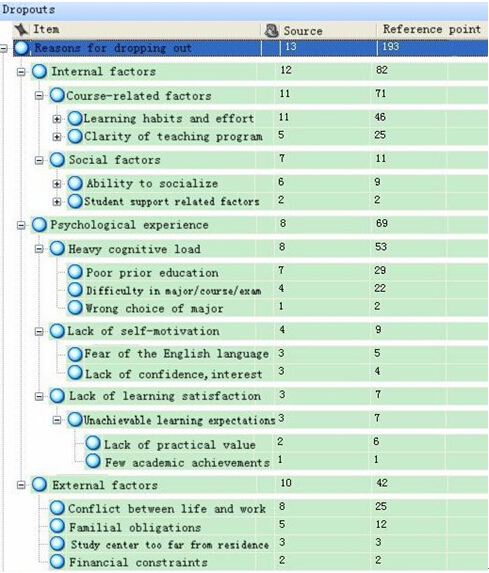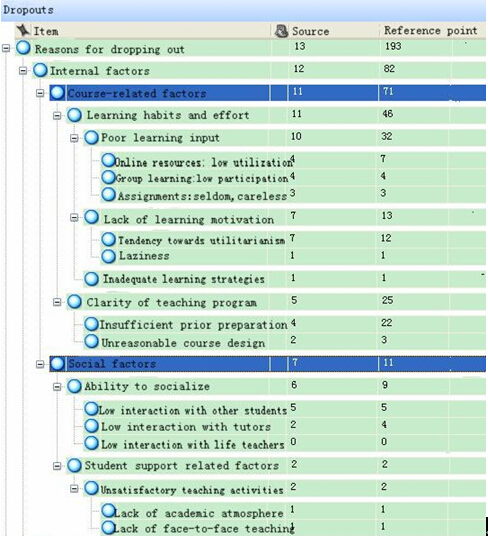2.2 Diploma programme
2.2.1 Before enrollment
Table 5 reveals the students’ ODL related abilities before enrollment, their personal characteristics and their academic background. Data is derived from online questionnaires submitted by 169 diploma programme students during the three semesters observed. This table shows that their average age is 23, 87.6% are single, 89.9% are childless and 49.7% work full time. In comparison with the dropouts from the bachelor’s degree programmes, they have an advantage in that they have more spare time to use in studying. However, as they are adult learners, they also face a number of different challenges arising from their daily life, work and study. The questionnaires indicate that “Time Management” is a major factor in ODL dropout rates. Table 5 further reveals that all of the dropouts are well prepared for a diploma course based on their educational background. However, 39.1% graduated from secondary vocational school, technical school or secondary technical school. Broadly speaking, the foundation knowledge of students who complete a high school course is stronger than those who graduated from secondary vocational school, since the former aims to train college and university students while the latter caters to the requirements of higher vocational school and immediate employment. Nearly 40% of dropouts graduated from secondary vocational school, which implies an insufficient educational foundation. 56.8% don’t participate in online learning regularly, which suggests that they are not able to learn using ICT-based methods. In summary, the dropouts from the diploma programme demonstrate a lack of preparation prior to enrollment.
Table 5 Pre-enrollment situation of diploma programme dropouts
|
Average age |
23 |
|
|
Gender(%) |
||
|
Female |
52.7 |
|
|
Male |
47.3 |
|
|
Marital status(%) |
||
|
Single |
87.6 |
|
|
Married |
11.8 |
|
|
Other |
0.6 |
|
|
Offspring(%) |
||
|
No |
89.9 |
|
|
Children |
10.1 |
|
|
Employment status(%) |
||
|
Full time |
49.7 |
|
|
Part time |
16.6 |
|
|
Unemployed |
33.7 |
|
|
Academic background(%) |
||
|
High school |
58.0 |
|
|
Secondary vocational school, technical school, secondary technical school |
39.1 |
|
|
College |
1.8 |
|
|
Bachelor’s or above |
0.6 |
|
|
Other |
0.6 |
|
|
Participation in school-organized online learning(%) |
||
|
Never |
10.1 |
|
|
Rarely |
46.7 |
|
|
Regularly |
43.2 |
|
2.2.2 After enrollment
A Dropouts in the first semester
Figures nine to twelve show a dropout attribution code pattern derived from interviews with first semester diploma programme dropouts, related professional tutors and teaching assistants. Figure 10 reflects “Internal Factors Closely Related to ODL Institutions”. From Figures nine, 11 and 12, we can see that dropouts, professional tutors and teaching assistants have different views on the factors contributing to dropout rates. The dropouts themselves emphasize internal factors (reference point 82), psychological experience (reference point 69) and external factors (reference point 42). The professional tutors agree with the teaching assistants and regard the factors contributing to ODL dropout rates as (in order of importance): psychological experience, internal factors and external factors. Figure 10 reveals the shortcomings of the dropouts: poor learning input (reference point 32), poor prior knowledge and skills (reference point 22), lack of learning motivation (reference point 13) and lack of student-teacher interaction, which is essential to ODL (reference point 9).

Figure 9 Dropout attribution code pattern for the first semester (diploma programme dropouts)

Figure 10 Dropout attribution (internal factors) code pattern for the first semester (diploma programme dropouts)